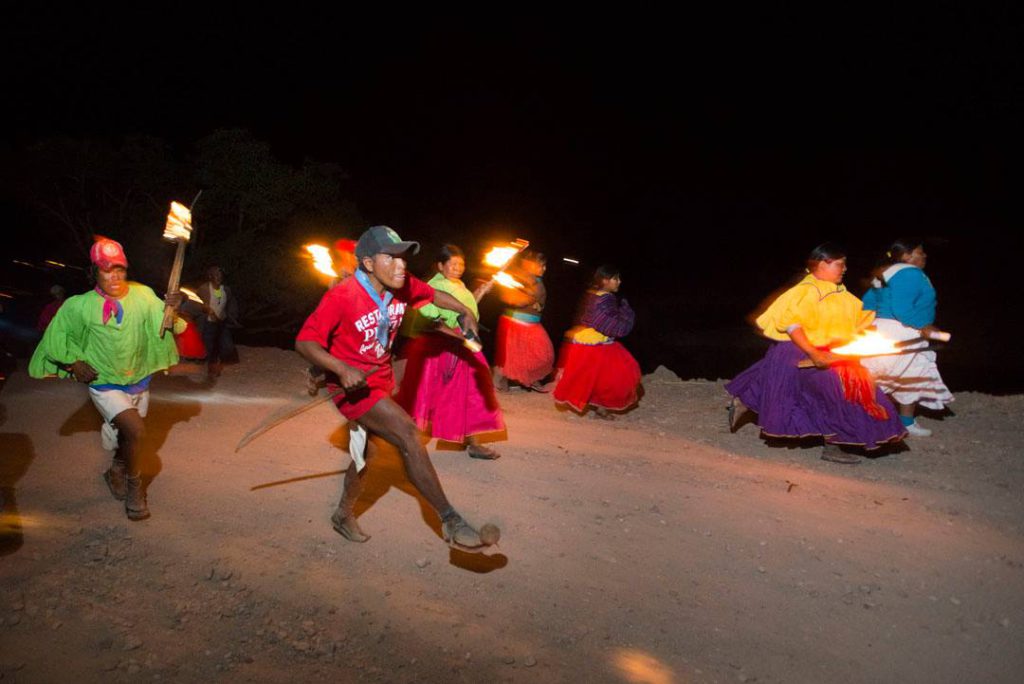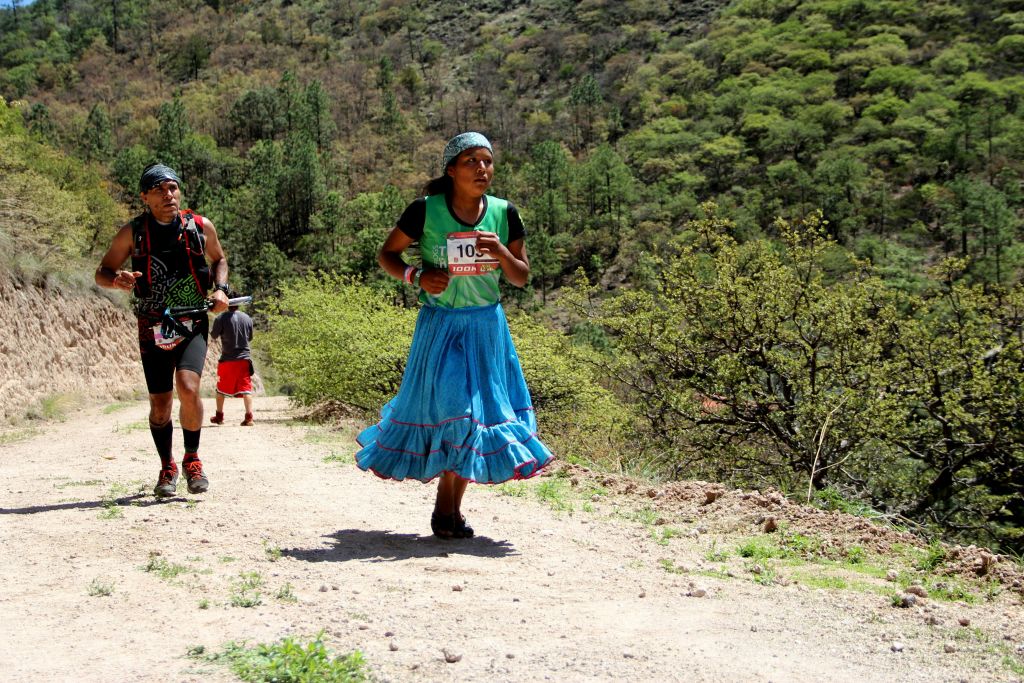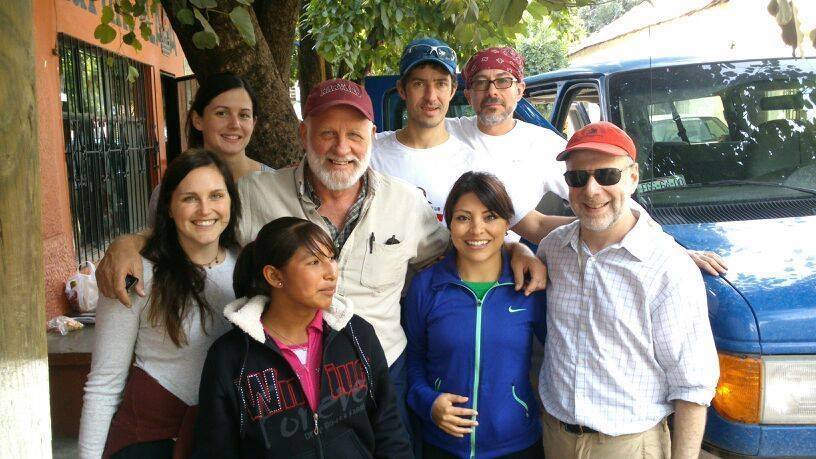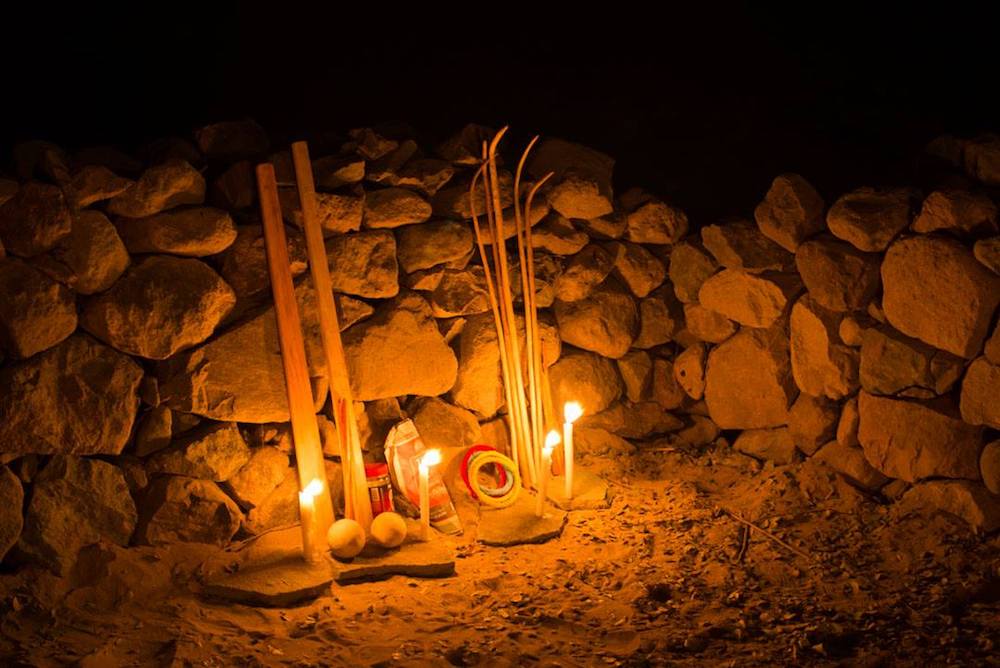Chasing the Myths of Mexico’s “Superrunners”

On a mesa above 6,000 feet in elevation among the Sierra Madre peaks of Northwestern Mexico, the Rarámuri racers, carrying flaming torches under a star-studded sky, ran steadily. The teams had been at this rarajípare event since noon and would persist past midnight.
The runners maintained a roughly 10-minute-mile pace, racing back and forth on a more than 3-mile track. Around them, people shouted encouragement in the Rarámuri language: “Iwériga!” (Breath! Soul!) and “Iwérisa!” (Stamina!).
In the midst of these colorfully clothed, torch-carrying followers was a figure clad in a sweatshirt and trail pants: Harvard anthropologist and marathoner Daniel Lieberman. Like the others present, he wore simple sandals called huaraches.
Lieberman had been filming the race to study the biomechanics of these fabled runners. He joined the melee after dark, keeping pace with them until the end. He, too, yelled encouragement and maneuvered his torch to help the team find their komakali, a baseball-sized wooden ball they kick forward as they race.
Close up, he noticed the trance-like state of the racers, which helped them combat their obvious signs of physical strain. “For them, this is spiritual,” Lieberman says, “a form of prayer, a symbol of how the world works and giving thanks to their God.”
Lieberman felt it too.
“How could I not?” he says. “I felt joy. It was one of the greatest runs of my life.”
That December night in 2013 was an important moment in what would become a landmark study, published in June 2020 in Current Anthropology. With an unusual group of co-authors, Lieberman investigates why endurance running so vibrantly survives among this remote tribe of Indigenous farmers (called Rarámuri in their own language or Tarahumara in Spanish).
“Talking about the traditional races of the Rarámuri community is important,” explains Irma Chávez Cruz, a member of the community, who is also an Indigenous rights activist. Understanding the races, she notes, requires firsthand experience, as Lieberman sought: “They have to see and ask questions and connect with the people.”
A community of some 80,000 inhabitants, the Rarámuri have risen to global prominence in recent years. Books and documentaries have drawn athletes and tourists to the races. Some Rarámuri runners now join ultramarathons all over the world.
But attention has coincided with complex changes. Energy bar and shoe companies have profited from products inspired by these “superrunners.” Traditional Rarámuri ways of life are under threat with the encroachment of mining, logging, climate change, organized crime, and the arrival of new technology, including cellphones. And misconceptions have swirled around this community.
Against this backdrop, Lieberman and his colleagues document how Rarámuri running remains intimately interconnected with the community’s culture, religion, and social life. He and his colleagues scientifically examine how the runners’ physiology does—and does not—contribute to their remarkable stamina. In the process, the authors debunk widely believed stereotypes and examine the deep spiritual significance of Rarámuri racing.
Lieberman, a biological anthropologist who studies the biomechanics of running, did not set out to write a comprehensive study of Rarámuri civilization. He is not a cultural anthropologist—nor does he see himself as a “crusader,” aiming to right wrongs. “I’m a foot guy,” he says.
That may be, but the Harvard professor is an inveterately curious fellow who pursues any path that intrigues him intellectually without knowing when—or if—he’ll write about it. Serendipity can play a role.
During a sabbatical year in 2012, Lieberman thought he’d stop in at a few running cultures like those in India and Kenya. The famous Rarámuri runners were on his list, having gained attention through the 2009 bestseller Born to Run by journalist Christopher McDougall.
To make that expedition happen, Lieberman contacted Mickey Mahaffey, a North Carolina native who’d lived among the Rarámuri people for two decades. He now directs a variety of nonprofit programs to benefit them, such as to build dams and support Indigenous schools.
Lieberman hired Mahaffey as his planner, tour guide, translator, and factotum. The pair became fast friends. For three weeks, they traveled from pueblo to pueblo in a hired pickup truck, slept on host families’ floors, and shared their tortillas, rice, and beans. In the pueblo of Urique, they danced along in a street festival celebrating La Virgen de Guadalupe. (The Rarámuri have incorporated some Christian rituals into their own faith.)
During their travels, near the town of Huisuchi, Lieberman met an elderly Rarámuri runner. Bristling with curiosity, the anthropologist asked the runner how he trained for his races. The man looked puzzled. Lieberman explained his own training regimen. Finally, the runner asked with incredulity, “Why would anyone run if they didn’t have to?”
This why pricked at Lieberman for an answer. In fact, he has written an entire book, published this year, devoted to the question: Exercised: Why Something We Never Evolved to Do Is Healthy and Rewarding.
In relation to the Rarámuri, the why is more specific. Traditionally, to hunt, a team of the best Rarámuri runners and trackers would chase their prey to exhaustion over several days. But about 40 years ago, the community acquired rifles for hunting—making persistence hunting mostly a thing of the past. Nonetheless, running events—particularly two footraces, the rarajípare and ariwete—remain cherished rituals.
Lieberman wanted to understand the persistence of these traditions.
To find answers, Lieberman went back twice to collect data, in 2013 and 2015. Along the way, he participated in rarajípares and assembled a set of collaborators with varied backgrounds.
Mahaffey became an invaluable co-author and cultural commentator, as did Rarámuri farmer and ultramarathoner Silvino Cubesare Quimare. Lieberman’s running buddy, cardiologist Aaron Baggish, a co–medical director of the Boston Marathon, provided invaluable physiological data.
Lieberman’s initial studies examined how the Rarámuri run, their foot-strikes, and the effects of different footwear. He found, for example, that minimal footwear, like huaraches, helps people develop a running style that is believed to be less susceptible to injuries than more structured shoes.
His observations quickly dispelled some of the more pernicious myths surrounding Rarámuri races. In the course of his research, Lieberman grew incensed as he read through more than 100 years’ worth of anthropologists’ reports.
Many previous scholars had perpetuated stereotypes of the “athletic savage,” “primitive” people of other races with extraordinary abilities who suffer no pain, unlike White athletes. (Even contemporary work, like McDougall’s book, repeats claims that the Rarámuri runners are faster than racehorses or cheetahs, with a “superhuman tolerance for pain.”)
“The belief that their abilities derive from natural racial characteristics dehumanizes them,” Lieberman says, “and denies them recognition of their talent, motivation, and hard work.” He also flags that the persistence of a similar pain tolerance mythology throughout current American medical practice has resulted in people of color and Indigenous people broadly being misdiagnosed and denied needed pain medication.
“The belief that [Rarámuri runners’] abilities derive from natural racial characteristics dehumanizes them,” says anthropologist Daniel Lieberman.
Speaking of the Rarámuri in particular, he adds, “The idea that they don’t suffer pain is disturbing and unethical and wrong.” He observed firsthand, for example, how the 12-hour-plus rarajípare clearly took a toll on runners. “For days after, they’re stiff and sore,” he notes. “Sometimes they get hurt.”
And Lieberman knew enough about the physiology of running to find it “absurd” that any human could run 65 miles without getting tired. Of course, they’re not panting at the end, he says, just like marathoners in Boston. Except for an occasional sprint, they run below their aerobic threshold. Simple as that.
Baggish, the director of the Cardiovascular Performance Program at Massachusetts General Hospital, made some complementary findings. Measured with a GPS, Baggish notes, the gait of Rarámuri runners is “pretty slow, done at a conversational pace, averaging about 10-minute miles.”
While Lieberman was studying feet, Baggish was collecting data on hearts. For this task, he had dragged along a generator and equipment to do echocardiograms, which allow for ultrasonic imaging of the heart. But before he did a single exam, he noticed: Nobody is running! In fact, he learned, it would be more accurate to describe the Rarámuri as a “walking people” rather than runners.
His echocardiograms shattered other preconceptions. “I thought we’d find the biggest and most robust hearts in the world,” Baggish says. “The athletic heart looks like almost a different organ from the sedentary heart in size, shape, and function. The Tarahumara hearts look surprisingly normal, like someone who is healthy and active but not athletic.” However, he did find that the hearts of aging individuals do not shrink and stiffen like those of typically active Bostonians who don’t exercise routinely.
The reasons for these remarkable findings were all around them. Everyday life for the Rarámuri people is rugged. Living miles from roads and one another, and without vehicles, Rarámuri citizens cover long distances to get from place to place. On an average day, they may trek thousands of feet up and down steep mountain trails. They chop wood, carry water, farm by hand without tractors, and tote heavy goods on their backs to nearby pueblos.
Beyond physiological measurements, Lieberman and his colleagues were fascinated by Rarámuri runners’ endurance. Whether running or dancing, footrace participants can remain in motion for hours or even days, with only brief rests. Yúmari dances, which often occur the night before a race or on other sacred occasions, can last from 12 to 24 hours.
During the rarajípares, Rarámuri runners achieve a trance-like state, which, Lieberman says, is not the same as a “runner’s high.” The difference, as he experienced himself, is spiritual.
A spiritual element was also essential to persistence hunting, a practice remembered by elders. To understand hunting’s relationship with running rituals and within the broader Rarámuri culture, the investigators began an oral history project with Mahaffey and Cubesare at the fore.
The pair were uniquely well-suited for the work. Mahaffey was once a teenaged Baptist preacher; in college, he studied Greek, Hebrew, and Aramaic for research and teaching, which helped him translate New Testament books. He later drifted from organized religion and in his 30s, poor health prompted him to radically change his lifestyle. At 40, he started a trek inspired by his understanding of Jesus as a man of simplicity and faith who was connected to nature and devoid of materialism—and a walker. This journey led him to the Rarámuri community, where he has remained since.
Mahaffey’s friend Cubesare, meanwhile, served as an additional interpreter and source. His bilingual Spanish and Rarámuri fluency made him an asset. In addition, Cubesare had, as a boy, participated in hunts. His memories and cultural knowledge could help the team piece together the stories of elders, whose recollections offered clues to the significance of running in the community.
They amassed over 60 questions to elicit details from each elder who’d participated in the hunts. A picture of the past gradually emerged. The best runners and trackers would go on a hunt for two days or more. Once they found deer tracks, they pursued their quarry, either running the deer to exhaustion or trapping it, such as in a ravine. They ran at moderate speeds, sometimes walked, and rested at night.
Before a hunt, elders recalled, hunters danced yúmari—a practice currently done before the rarajípare and ariwete. This ancient ceremonial ritual petitions the god Onorúame for blessings and offers thanks. “They don’t verbalize it,” Mahaffey says. “The act itself is a prayer for crops and health.”
Elders also discussed the symbolic significance of the footraces. Several compared the effort to guide the unpredictable ball over the long race to “navigating the complex, chaotic journey of life.”
Spirituality and prayer infuse many aspects of the race. Teams want to win and celebrate their victories but don’t partake in an intensely competitive spirit. During the yúmari before a rarajípare, a shaman or leader exhorts the runners to remember that they are running for Onorúame: They must work as teammates and not get angry at one another.
Supportive shouts to runners indicate the interconnectedness the Rarámuri people see between the spiritual and physiological: life, breath, soul, and strength. The Rarámuri believe that when Onorúame created them from clay, he gave them the breath of life, and their shamans sometimes blow on the sick to cure them.
Iwériga is “a beautiful word,” says Mickey Mahaffey, “sending the power of your soul to another.”
Women play a special role in sharing strength. For example, the younger women, ages 10 through 20, often run the shorter ariwete (about 25 miles) simultaneously with the rarajípare. In the ariwete, the racers use hooked sticks to flick a hoop as they run. Afterward they join the throng with the men. When a runner is exhausted, as many as 20 women may surround him on the course, matching his stride and chanting in unison: “Iwériga!”
“It’s a beautiful word,” Mahaffey says, “sending the power of your soul to another.”
Rarámuri men speak of the “poder de mujer,” Spanish for “power of women.” The women bring food and pinole, dried corn ground and mixed with water, that the racers rely on for energy.
The footraces also serve social and economic functions. Held from two to eight times a year, they bring together friends and relatives from far-flung farms to socialize, reminisce, tell stories, and laugh. They also bet on the races, winning goods or money.
“Economically,” says anthropologist Jerome Levi, a professor emeritus of Carleton College, “these events are ways to redistribute resources. … And there’s a sociopolitical dimension.” He adds, “It allows people to achieve status in an otherwise relatively egalitarian society. You don’t get to be a headman by being a good runner. But it helps.”
Levi is deeply knowledgeable about the Rarámuri from his own time with them in the 1980s. He says that his calling the new work “a welcome contribution” is in fact an “understatement.” He applauds it for placing Rarámuri running within its religious, cultural, and historical context.
Rarámuri running traditions can also be understood as one example among many of the significance of running traditions in Native American cultures. Dustin Quinn Martin, the executive director of Wings of America, a running initiative for Native youth, and a member of the Navajo Nation, makes that case.
“I know there are tribal people all over this continent that, whether they have a 4×4 truck available or not,” Martin says, “they still make a conscious effort to get out and move on the earth as a way of connecting with their landscape and their spirituality.”
Indeed, the themes of nature, tradition, and spirituality arise when activist Chávez reflects on the importance of running. Among the benefits of racing, she says, is “it allows us to be in harmony with nature.” She also flags the races’ role in connecting community and supporting health.
For Chávez, the new research offers an opportunity to help people outside her community better understand Rarámuri racing—and to document longstanding practices. “These are traditional games that we have practiced for many years, that our grandparents and our ancestors left to us,” she reflects, “to continue running across the land.”

































